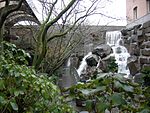Fallen Firefighters Memorial (Wu)
1998 establishments in Washington (state)1998 sculpturesBronze sculptures in Washington (state)Firefighting in the United StatesFirefighting memorials ... and 8 more
Monuments and memorials in SeattleOutdoor sculptures in SeattlePioneer Square, SeattlePublic art stubsSculptures of men in Washington (state)Seattle Fire DepartmentStatues in SeattleWashington (state) sculpture stubs
Fallen Firefighters Memorial is a bronze sculpture group by Hai Ying Wu.It is located in Occidental Park, Seattle, near the intersection of Occidental Avenue and Main Street. It was inspired by the deaths of four Seattle firefighters who died January 5, 1995 fighting a fire in the Mary Pang warehouse in Seattle's International District.
Excerpt from the Wikipedia article Fallen Firefighters Memorial (Wu) (License: CC BY-SA 3.0, Authors).Fallen Firefighters Memorial (Wu)
Occidental Avenue South, Seattle International District/Chinatown
Geographical coordinates (GPS) Address External links Nearby Places Show on map
Geographical coordinates (GPS)
| Latitude | Longitude |
|---|---|
| N 47.600183333333 ° | E -122.33291666667 ° |
Address
Seattle Fallen Fire Fighters' Memorial
Occidental Avenue South
98104 Seattle, International District/Chinatown
Washington, United States
Open on Google Maps







